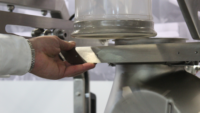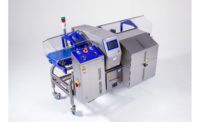Contaminant Detection in Food Processing

Current inspection technologies for meat, poultry, and other soft food products can miss very small fragments of bone, metal, glass, and other foreign materials—or lead to ambiguous results that require time-intensive verification. We have developed an approach that significantly improves detection probabilities and reduces the need for manual verification. The use of microfocus, dual-energy radiographic imaging along with advanced algorithms can detect and identify contaminants.
 Three components are combined to vastly improve the accuracy and resolution of contaminant detection. A microfocus X-ray tube allows smaller objects to be seen and provides better measurements for dual-energy attenuation properties. Dual-energy radiography, using both high-energy (HE) and low-energy (LE) tube outputs produces two radiographic images. Materials with different radiographic densities respond differently to HE and LE, providing the basis for dual-energy radiography. A physics-based computer algorithm combines the two images to produce a third detailed image, enhancing the presence of nonfood materials. These results can be analyzed to identify the contaminants (Figure 1).
Three components are combined to vastly improve the accuracy and resolution of contaminant detection. A microfocus X-ray tube allows smaller objects to be seen and provides better measurements for dual-energy attenuation properties. Dual-energy radiography, using both high-energy (HE) and low-energy (LE) tube outputs produces two radiographic images. Materials with different radiographic densities respond differently to HE and LE, providing the basis for dual-energy radiography. A physics-based computer algorithm combines the two images to produce a third detailed image, enhancing the presence of nonfood materials. These results can be analyzed to identify the contaminants (Figure 1).
Combining these approaches provides better results than are possible with other approaches used today. The microfocus technique improves the dual-energy process and allows for more accurate measurement of radiographic density.
Maximizing the Probability of Detection for the Food Industry
We have tested this approach to detect contaminants in meat and poultry. Testing demonstrated accurately detection and identification of glass, bone, and plastic fragments as small as 1 mm in diameter in meat and poultry.
 Improving the probability of detection for contamination would provide significant benefits for the meat and poultry industry. Conventional screening systems have a probability of detection for bone fragments between 3–4 mm of 50–70 percent. Using either microfocus or dual energy alone provides measurable improvement. When both of these methods are combined with a smart algorithm, the probability of detection for bone fragments of this size nears 100 percent (Figure 2).
Improving the probability of detection for contamination would provide significant benefits for the meat and poultry industry. Conventional screening systems have a probability of detection for bone fragments between 3–4 mm of 50–70 percent. Using either microfocus or dual energy alone provides measurable improvement. When both of these methods are combined with a smart algorithm, the probability of detection for bone fragments of this size nears 100 percent (Figure 2).
Implications for Other Food Products
In addition to improved detection capabilities, this approach offers several advantages for both food safety and security applications.
• It is noninvasive and can be used with already packaged products.
• It can be retrofited into existing inspection and security systems, so conveyor belts or other mechanical components of the system can still be used.
• It does not slow down throughput.
• It requires minimal retraining for inspection staff.
While the current system has been optimized for detection of certain contaminants in meat and poultry, with additional training of the algorithm, the same method could be applied to detect foreign objects in other food products.
Vicki A. Barbur Ph.D., is senior director, IP and Technology Commercialization, Batelle, and Richard J. Davis is senior research leader, Battelle.
Looking for a reprint of this article?
From high-res PDFs to custom plaques, order your copy today!








